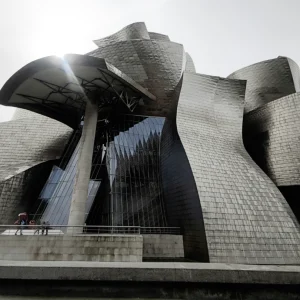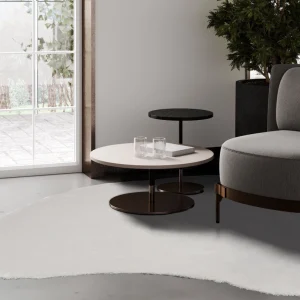IN PREPARATION for a major refurbishment kicking off next year, the Royal Institute of British Architects (RIBA) is taking a closer look at the architecture of the institution itself. In an exhibition aptly called Raise the Roof: Building for Change, it is lifting the lid on some of the narratives that are literally embedded in its landmark, Grade II listed HQ at 66 Portland Place.
 The Henry Florence Memorial Hall at RIBA; Denis Dunlop working in his studio on the panels of a screen representing the fauna, industries, people and flora of the five Dominions. Image Credit: Architectural Press Archive / Riba Collections
The Henry Florence Memorial Hall at RIBA; Denis Dunlop working in his studio on the panels of a screen representing the fauna, industries, people and flora of the five Dominions. Image Credit: Architectural Press Archive / Riba Collections
Never mind the high pomp of the neoclassical façade – a building The Guardian’s Oliver Wainwright wittily described as ‘part Egyptian tomb, part masonic temple’ – far more toxic narratives are displayed inside, in particular the Jarvis Mural in the grand auditorium; scuffed and faded you could be forgiven for not having noticed it. It was conceived, as was the building, in the 1930s, probably the final decade of Britain’s confidence in its ongoing global dominance. At its centre is a map of Britain, surmounted by a parliament of architects, and ringed by imperial buildings, from government palaces in Pretoria and New Delhi to the old parliament of Canberra, all designed by RIBA members. Around the mural’s edges, seemingly subservient natives are depicted semi-naked along with tropical flora and fauna.
Thandi Loewenson, Zimbabwe-born architectural designer and researcher, has described it as ‘one of the most racist things I’ve ever seen in my life’. Thanks to RIBA curator Margaret Cubbage, Loewenson, along with three other architects and artists, has been commissioned to come up with a response that interrogates the building’s imagery and exposes its problematic origins. Loewenson’s work focuses not just on the colonial architecture that is referenced on the screen but the extractive infrastructure that has had an even worse impact. Her work, titled Blacklight, shows a layering of images etched into graphite panels. Over the triumphant colonial Zambian image from the Jarvis screen she has laid a 1921 drawing of the Broken Hill lead and zinc mine in Kabwe, Zambia, one of the first colonial mines and now one of the most toxic sites on the planet. She has also scribbled in graphite a desired erasure over these symbols, something she says she would like to be allowed to do on the actual screen, though its listing makes the Art Deco interiors sacrosanct.
 Indian born artist and designer Arinjoy Sen has created a rainbow-bright alternative to the Jarvis Mural that places the indigenous subjects of the original centre stage in a carnival of hope; architect and designer Giles Tettey Nartey, who grew up in Ghana, has reacted to the Dominion Screen with beautifully curved stools carved from the same Canadian pine but stained black. Image Credit: Agnese Sanvito
Indian born artist and designer Arinjoy Sen has created a rainbow-bright alternative to the Jarvis Mural that places the indigenous subjects of the original centre stage in a carnival of hope; architect and designer Giles Tettey Nartey, who grew up in Ghana, has reacted to the Dominion Screen with beautifully curved stools carved from the same Canadian pine but stained black. Image Credit: Agnese Sanvito
What this work makes clear is that the territories and people depicted in the Jarvis Mural – and also the Florence Hall Dominion Screen, an equally problematic, carved timber panel elsewhere in the building – are being proudly displayed as resources for UK enrichment and trade, extractive capitalism writ large. Says Cubbage: ‘The commissioned work asks questions around these resources and who and what is impacted.’
Architect and designer Giles Tettey Nartey, who grew up in Ghana, has reacted to the Dominion Screen with beautifully curved stools carved from the same Canadian pine but stained black. These loose components can be arranged and reconfigured as desired – a fluidity that resonates with the conversational shifts emerging in the profession around multi-disciplinarity and collaboration. The aforementioned works also chime with the prevailing focus on where materials are sourced from and how to minimise impact. The RIBA building uses African marble on its processional staircase, a silvery wood from India on its hall floors, and Canadian maple and Australian walnut on its panelled walls.
 Indian born artist and designer Arinjoy Sen has created a rainbow-bright alternative to the Jarvis Mural that places the indigenous subjects of the original centre stage in a carnival of hope; architect and designer Giles Tettey Nartey, who grew up in Ghana, has reacted to the Dominion Screen with beautifully curved stools carved from the same Canadian pine but stained black. Image Credit: Agnese Sanvito
Indian born artist and designer Arinjoy Sen has created a rainbow-bright alternative to the Jarvis Mural that places the indigenous subjects of the original centre stage in a carnival of hope; architect and designer Giles Tettey Nartey, who grew up in Ghana, has reacted to the Dominion Screen with beautifully curved stools carved from the same Canadian pine but stained black. Image Credit: Agnese Sanvito
The third work is from Indian-born artist and designer Arinjoy Sen: a rainbow-bright alternative to the Jarvis Mural that places the indigenous subjects of the original centre stage in a carnival of hope.
It feels right that the RIBA is making visible some of the narratives that for so long have been ignored or subsumed beneath what now seems a very 20th-century imperative to celebrate architects as creative geniuses reshaping our world, never mind the impact that this has on the earth and its multitude of occupants. Now with its youngest and first black president, Nigerian-born Muyiwa Oki, at the helm, it is necessary to show that these changes go deeper than surface decoration and prominent personnel.
And change is what we will see in the new building, I’m told. The four-year, £85m refurbishment is set to ‘widen access to architecture’, on all fronts. Its world-class, four million-item architectural collection, currently dispersed across five UK settings (including the V&A), will be united, catalogued and conserved, the better to be deployed across two spaces: the existing Architecture Gallery along with a new, museum-standard exhibition space. These and other archive and library assets will be shared with a wider audience on improved digital platforms, accessible by the RIBA’s thousands of international members, as well as the general public. The building will have its ageing and incompetent heating upgraded, thermal efficiency improved and all 28 levels will be accessible by a new, larger lift. A fully accessible entrance on Weymouth Street will usher visitors into a ‘destination cafe’ full of models and drawings that, along with the relocated shop, will make all visitors feel welcome, not just RIBA members.
 Thandi Loewenson's Blacklight. Image Credit: Agnese Sanvito
Thandi Loewenson's Blacklight. Image Credit: Agnese Sanvito
RIBA president Oki says: ‘We want RIBA to be at the heart of a global architecture community where important ideas – including how we design a low-carbon future – are developed and shared.’
That inclusivity is also apparent in the fourth work in this small, sparely designed but punchy exhibition: a film by artist Esi Eshun, in which she tours the building, staring up at its façade, standing in its column-flanked doorway, looking at the colonial structures, infrastructure and aesthetics behind them. She calls the Dominion Screen ‘a cartography of desire and despair’. Opening in the week that Lesley Lokko received the RIBA gold medal – the first black woman to be awarded this prize – the exhibition and the ensuing reorganisation set a hopeful tone for this 190-year-old institution, and the building itself which celebrates its 90th birthday this year.





